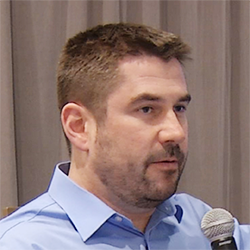In this video Dr. Goldstein discusses ways to manage patients with neurogenic orthostatic hypotension.
In this video we’ll be talking about the management of neurogenic orthostatic hypotension.
The main principle of management of neurogenic orthostatic hypotension is education also. The patient has to know his or herself and you can’t tell from symptoms. The only way to tell if you have hypotension is to measure the blood pressure, people have to learn to measure their blood pressure. They have to recognize the symptoms that fit with orthostatic hypotension such as the Coat Hanger phenomenon, clouded thinking when the person is standing up, overt fainting in a patient with neurogenic orthostatic hypotension is rare – it can happen but usually people know what is going on, it happens every time they get up and so they try to lie down. People with neurogenic orthostatic hypotension are worst in the morning, because they are worst in the morning, they should be taken their shower, their hot shower at night, not in the morning. Because of postprandial hypotension, I told you about the Miami-Chinese restaurant syndrome, because of the postprandial hypotension people with neurogenic orthostatic hypotension should be taking frequent, small, snack-like meals. In people with neurogenic orthostatic hypotension, the bathroom is a dangerous place. I know two people, or I knew two people, who had pure autonomic failure who died in the bathroom. They died in the bathroom because they are straining, they are sitting still, they are having these Valsalva maneuvers – the blood pressures is going down, down, down, and one of them actually was in a restaurant when this happened it was for his 60th birthday. In men don’t pee standing up if you have neurogenic orthostatic hypotension. I made that sign; you are not going to see it anywhere else.
It’s important to recognize the difference between hypotension during exercise and hypotension after exercise. Neurogenic orthostatic hypotension, you’re talking about hypotension after exercise, with the person who has hypotension during exercise that’s something else and that has to be worked up. Antigravity muscle training just means that, remember the pretzel leg sign, if you have great muscle tone in your backside, your thighs and calves, you will be able to muscle pump more efficiently get the blood up towards the chest. People with neurogenic orthostatic hypotension ought to have a medic-alert band and in the person’s wallet there will be a piece of paper that says “I have neurogenic orthostatic hypotension”. It’s important for people with neurogenic orthostatic hypotension to elevate the head of the bed, this decreases the shock of getting out of bed in the morning. Overnight in the patient with neurogenic orthostatic hypotension, often the blood pressure is too high and the brain says, “I don’t need all this blood pressure. I am going to turn that blood into urine” and that’s typically why people, healthy people, they have the pee when they wake up in the morning that’s just part of life. The brain has translated blood volume into urine. In somebody with neurogenic orthostatic hypotension, they have pressured natriuresis and when they had their high blood pressure at night, they lose sodium and water in the urine. That’s why the blood pressure is lowest in the morning, I think. The orthostatic hypotension is worst and you can kind of minimize that shock by just simply elevating the head of the bed. Jens Jordan discovered that drinking 16 ounces of water will raise the blood pressure within about 15 minutes and it can last for an hour – very handy to know. We are not talking about Gatorade, just water. This shows the, this actually is from Jens’ work showing the pretty substantial increase in blood pressure after drinking 16 ounces of water, is in people who have neurogenic orthostatic hypotension. The very last part of this is drugs. Remember I mentioned finding denervation super sensitivity I think is important, but they are risks to treating neurogenic orthostatic hypotension with alpha adrenal receptor agonist. One is in a man anyway, the symptoms of prostatism can be worse and you can have acute urinary retention that’s very-very nasty.
Drugs are stupid, let me explain. A drug is not going to know what posture you are in and if you’re taking a pressor agent to raise your blood pressure when you’re standing up, that drug is still going to be working when you’re laying down and the drug could cause an excessive increase in blood pressure when you’re laying down.
Mesenteric ischemia is kind of straightforward in somebody who has got atherosclerosis of blood vessels to the gut. An acute vasoconstriction could precipitate a disaster in terms of mesenteric ischemia and infarction and there is also the serotonin syndrome. I want to talk a little bit about midodrine. Midodrine is still approved as an orderly acting alpha adrenal receptor agonist. Alright, here is one quiz questions. Midodrine stimulates norepinephrine receptors, is midodrine is a catechol? No, it’s not a catechol, it looks very much like phenylephrine. Phenylephrine is a classic, it’s Neo-Synephrine for the old fashioned short-acting Neo-Synephrine. It’s an alpha adrenal receptor agonist. Is phenylephrine a catechol? No. Now suppose I were to make this a catechol. What is that? It’s adrenaline. So, somehow adding that hydroxyl group there, somehow it turns an alpha adrenal receptor agonist into adrenaline which is a nonselective alpha and beta adrenal receptor agonist, it’s kind of cool. Anyway, midodrine is an alpha adrenal receptor agonist, it’s analogous to phenylephrine, I think you can see that. I do not know what midodrine would be if it were a catechol. Somebody must have looked into that. Florinef is fludrocortisone, it’s a salt retaining steroid, it forces the kidneys to retain salt and water. It looks very much like the salt retaining steroid of the body aldosterone. Aldosterone is a main salt retaining hormone of the body and Florinef forces your kidneys to retain salt and water, so it will increase blood volume, at least that’s the theory and then that will increase blood pressure. Actually, nobody knows whether the increase in blood pressure with Florinef given long-term is a result of an increase in blood volume. It could very well be it’s not, instead the Florinef causes salt and water retention in the walls of blood vessels and sort of waterlogs of blood vessels and the lumen of the blood vessels, gets smaller and peripheral resistance goes up instead of the blood volume and cardiac output going up. Florinef is a salt retaining steroid that means it’s trading off sodium for potassium that means you have to kind of monitor serum electrolytes every once in a while, to make sure the person isn’t becoming hypokalemic. Also, in order for Florinef to work you have to be on a high salt diet. It would be schizophrenic to treat somebody with Florinef and a diuretic for edema, but it’s done, really is crazy. So, when you put somebody on Florinef and a high salt diet you say the drug is working if you gained weight, gain fluid weight, so we want to see if you are taking in enough salt for the Florinef to work. Acetylcholinesterase inhibitors are sort of used I think less commonly nowadays, brand name will be Mestinon. This is something that Philip Lowe at Mayo and his group developed. The concept is pretty simple if there are nicotinic cholinergic receptors involved in all ganglionic transmission. Then, if you block the metabolism of acetylcholine by having a acetylcholinesterase inhibitor, we are going to deliver more acetylcholine to the nicotinic receptors is going to increase ganglionic transmission and partly because of the norepinephrine that’s released you will increase the blood pressure. It is much more complex than that and well that is the idea. The last drug I will talk about is L-DOPS, or Northera, which is marketed by Lundbeck. L-DOPS and L-DOPA are very similar. L‑DOPS gets turned into the norepinephrine and L-dopa gets turned into dopamine by way of this enzyme L aromatic amino acid decarboxylase or dopa decarboxylase. Is L‑DOPS a catechol? Yes, L-DOPS is a catechol. What about DOPA? Is DOPA is a catechol? Yeah, all these are catechols.

Wolfgang Singer, MD
Associate Professor of Neurology
Mayo Clinic Rochester, MN































